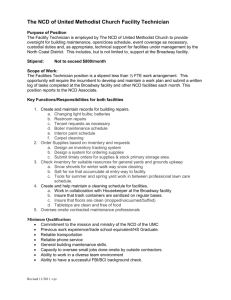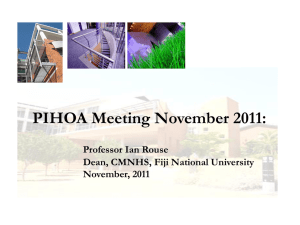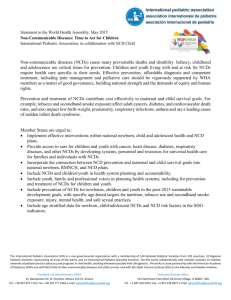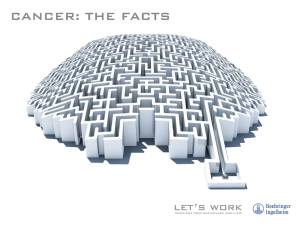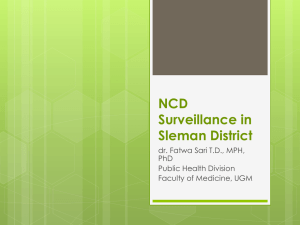Cancer Epidemiology In India
advertisement
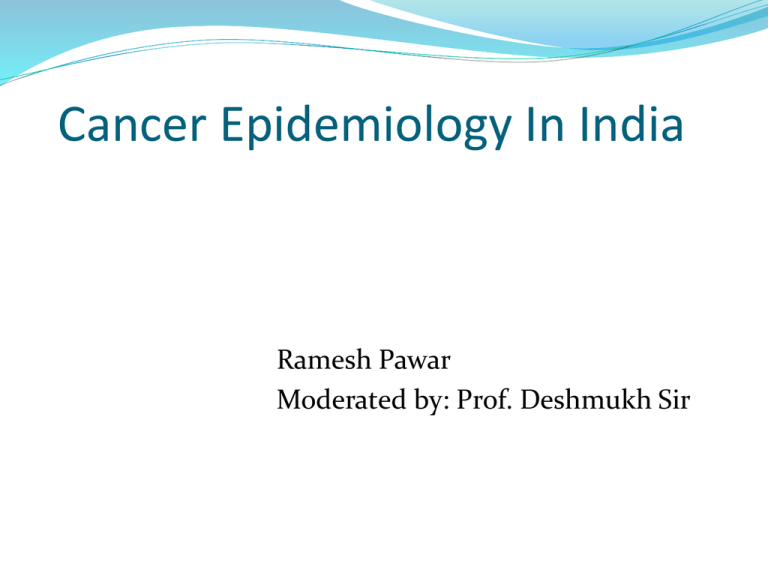
Cancer Epidemiology In India Ramesh Pawar Moderated by: Prof. Deshmukh Sir Framework Definition Introduction Magnitude Risk factors National programme Cancer registry and Atlas Cancer registry at MGIMS, Sevagram References Cancer Cancer refers to a class of diseases in which a cell or group of cells divide and replicate uncontrollably, intrude into adjacent cells and tissues( invasion) and ultimately spread to other parts of the body than the location at which they rose ( metastasis) ( national cancer Institute) Introduction India is experiencing a rapid health transition with rising burden of Non Communicable diseases (NCDs). Overall NCDs are emerging as the leading cause of death and disability in India accounting for over 42% of all deaths (Registrar General of India). According to national commission on macroeconomics and Health (NCMH) report (2005), the crude incidence rate for Cervix cancer, beast cancer and oral cancer is 21.3, 17.1 and 11.8 (among both men and women) per 100,000 population respectively. Cancer registry data reveals that 48% of cancer in males and 20% in females are tobacco related and are totally avoidable. 75-80% patients are in advanced stage of disease at the time of first attendance Burden of Cancer: Global Estimated age-standardised incidence and mortality rates: men and women MEN WOMEN Source: http://globocan.iarc.fr/factsheet.asp Global Estimated age-standardised incidence and mortality rates: Men Source: http://globocan.iarc.fr/factsheet.asp Global Estimated age-standardised incidence and mortality rates: Women Source: http://globocan.iarc.fr/factsheet.asp Global Estimated age-standardised incidence and mortality rates: both men and women Source: http://globocan.iarc.fr/factsheet.asp INDIA India: Estimated age-standardised incidence and mortality rates: men and women Men Women http://globocan.iarc.fr/factsheet.asp India Estimated age-standardised incidence and mortality rates: Men http://globocan.iarc.fr/factsheet.asp India Estimated age-standardised incidence and mortality rates: Women http://globocan.iarc.fr/factsheet.asp Cancer Burden: India Caner has become one of the ten leading causes of death in India. It is estimated that there are nearly 2-2.5 million cancer cases at any given point of time. 8-9 lakh new cases and 4 lakh deaths occur annually due to cancer. Cancer of oral cavity and lungs and in males and cervix and breast in females account for 50% of all cancer deaths in India WHO has estimated that 91% of oral cancers in SEAR directly attributable to the use of tobacco and this is the leading cause of oral cavity and lung cancer in India. By 2050, there will be 17 million new cases in the developing world (Farlay et al 2004) Risk factors for cancers: o Genetic factors o Retinoblastoma (RB1) o Interaction of gene and environment o Mutation in some p53 codons are more prevalent in cancer of a particular organ. http://p53.free.fr/Database/p53_cancer/all_cancer.html Risk factors o Infection o approximately 20% of the cancers among men and women in developing countries is attributed for infectious agents as opposed to 9% in developed countries.(Pisanil 1997) o Hep B & C, HPV. o Tobacco o Responsible for about 40 to 50% of cancers in men and about 20% of cancers in women (Percentage) 61 57 50 13 11 7 Urban Rural Women Total Men NFHS-3, 2005-06 NFHS-3, 2005-06 (Percentage) 33 31 1 Urban 3 Alcohol use by women is rare. 2 Rural Women 32 Total Men NFHS-3, 2005-06 NFHS-3, 2005-06 Risk factors o Diet o o o o In India dietary habits responsible for about 10-20% of cancers. The changing dietary patterns particularly involving animal proteins. Consumption of large amount of red chillies, food at very high temperatures and alcohol consumption are the main risk factors for stomach cancer in India Tuibur –Mizorum Source: WHO (2003) RTS 916. Diet, Nutrition and prevention of chronic diseases. Risk factors Pesticides Malwa region of Punjab- a cotton belt “Cancer train” ( sengupta N.A. train ride to cancer care. Times of India 2011) Breast cancer: late age at 1st pregnancy, single child, late menopause, high fat diet. Cancer cervix: early marriage, multiple sexual partner, multiple pregnancy ,poor sexual hygiene. Education and socio-economic status. Physical inactivity and life style Life style factors and risk of developing cancer Source: WHO TRS 916. Diet, nutrition and prevention of chronic diseases. Criteria for Screening Disease should be an important public health problem Must have a latent asymptomatic stage Adequate treatment should be available The test should be safe and relatively in-expansive Capable of rapid application Should be accurate and reproducible Test should be acceptable to people The test should be reasonably inexpensive Adequate follow up of the positives should be ensured Undesired harm due to screening should be avoided Early warning signals If someone notice following symptoms she/he should contact to health centre immediately: A sore that doesn’t heal Recent changes in wart or mole Unusual bleeding/discharge/per vagina/rectum Persistent cough or hoarseness of voice Persistent change in bladder/bowel habits Difficulty in swallowing Painless lump or swallowing. National programme for prevention and control of cancer, diabetes, cardiovascular diseases and stroke Pilot programme was launched on 4th January 2008 in 7 states covering one district each Objectives Prevent and control common NCDs through behaviour and life style changes. Provide early diagnosis and management of common NCDs Built capacity at various levels of health care for prevention, diagnosis and treatment of NCDs. Train human resource within the public health setup viz doctors, paramedics and nursing staff to cope with the increasing burden of NCDs Establish and develop capacity for palliative and rehabilitative care. India Map showing the states to implement NPCDCS Operational guidelines. (NPCDCS).Director General of Health services Ministry of health and family welfare Government of India. Strategies Prevention through behaviour change Early diagnosis Treatment Capacity building of human resource Surveillance, monitoring and evaluation 1. Prevention through behaviour change Creating general awareness Promotion of healthy life style habits The various approaches such as community education communication and mass media, interpersonal Increase intake of healthy food Increased physical activity through sports, exercise etc. Avoidance of tobacco and alcohol Stress management Warning signs of cancer etc. 2.A Early diagnosis Strategy for early diagnosis of chronic non communicable diseases will consist of opportunistic screening of person above the age of 30 yrs at the point of primary contact with any health care facility, be it the village, CHC, district hospital, tertiary care hospital. Opportunistic screening will have in built component of mass awareness creation, self screening and trained health care providers. Involves simple clinical examination comprising of relevant questions and easily conducted physical examination (such as h/o tobacco consumption and measurement of blood pressure etc.) 2.B Treatment Screening, diagnosis and management (including diet counselling, lifestyle management ) and home based care will be the key functions. 2.C Home based care One of the nurse-home visit for bedridden cases. Supervise work of health worker and attend monthly clinic held in villages on a random basis. Advice patient about care Refer if required. 2.C Referral 3.Palliative care Affirms life and dying as a natural process Neither hastens nor postpones death Active total care of patients and families by multi- professional team. Services available under NPCDCS at different levels Packages of services to be made available at different levels under NPCDCS Management structure: National NCD Cell NCD Cell will be responsible for overall planning, implementation, monitoring, and evaluation of different activities and achievement of physical and financial target planned under the programme. Organization structure of National NCD cell Technical wing Administrative wing Deputy Director General Additional secretary/Joint secretary CMO( Cancer) Director(NCD) CMO(Dibetes andCVD) Under secretary (NCD) CMO (Geriatric care) Under secretary(NCD) Consultant Section officer The national NCD cell is supported by following staff Sr.No. Name of post No. of post 1 2 National programme officer(NCD) National programme officer(training and coordination) 1 1 3 4 5 6 7 8 9 10 11 12 13 14 National program officer ( M & E and surveillance) National epidemiologist Functional consultant Technical officer (health management) Technical officer( Nutrition) Technical officer (Physiotherapy) Technical officer (IEC) Logistic co coordinator M & E officer Data manager Computer assistant Technical assistant Total 1 1 1 1 1 1 1 1 1 1 2 2 16 Role and responsibilities of National NCD Cell is as under Plan, Coordinate, and Monitor all the activities at National and State level. Develop operational guidelines, Standard Operating Procedures (SOP), Training modules, Quality benchmarks, Monitoring and reporting systems and tools. Monitoring and evaluation of the programme through HMIS, Review meetings, Field observations, surveillance, operational research and evaluation studies. Prepare National Training Plan: Curriculum, Training resource centres, training modules and organize national level training programmes Procurement of equipment and supplies for items to be provided as commodity assistance; Release of funds and monitoring of expenditure State NCD cell The Cell shall function under the guidance of State programme Officer (SPO NCD) and will be supported by the identified officers/officials from the Directorate /Director General of Health Services. SPO (NCD) will be a State level health official identified by the State government. 1. State Programme Officer 2. Programme Assistant 3. Finance cum Logistics Officer 4. Data Entry Operators (2) A. Health promotion: Behaviour and life style changes Sub centre level Carried out by the front line health workers- ANM and (or) Male Health Worker. Camp, interpersonal communication (IPC), posters, banners Educate people at community/school/workplace settings. Increased intake of healthy foods Increased physical activity through sports, exercise, etc.; Avoidance of tobacco and alcohol; Stress management Warning signs of cancer etc. B Opportunistic Screening During the camps/ designated day ANM and (or) Male Health Worker also examine persons at and above the age of 30 years for alcohol and tobacco intake, physical activity, blood sugar and blood pressure. During the examination, health worker shall also carry out the measurement of weight, height, and Body Mass Index (BMI) etc. C. Referral ANM and (or) Male Health Worker refer the suspected case of Diabetes and Hypertension to the CHC or higher Health Facility for further diagnosis and management D. Data recording and reporting ANM and (or) Male Health Worker at Sub Centre maintain in prescribed format to related CHC under the programme and submit the report monthly to CHC. Activities at Community Health Centre A. Screening B. Prevention and health promotion C. Laboratory investigations D. Diagnosis and Management E. Home based care F. Referral Human Resources for CHC NCD services a. Doctor (1) b. Nurses (2) c. Counsellor (1) d. Data Entry Operator (1) Activities at District Level The selected districts provide the full complement of preventive, supportive and curative services for NCD ‘NCD clinic’ A. Opportunistic screening B. Detailed investigation C. Outsourcing of certain laboratory investigations D. Out-patient and In-patient Care E. Day Care Chemotherapy Facility F. Home Based Palliative Care G. Referral & Transport facility to serious patients H. Health promotion I. Training J. Data recording and reporting K. Human Resources at District Hospital a. Doctor (specialist in Diabetology/Cardiology/M.D Physician) b. Medical Oncologist c. Cyto-pathologist d. Cytopathology Technician e. Nurses (4): 2 for Day Care, one for Cardiac Care Unit, one for O.P.D f. Physiotherapist g. Counsellor h. Data Entry Operator i. Care coordinator NPCDCS District covered during 2010-11 National cancer registry Programme: Cancer registration is the process of systemically and continuously collecting information on malignant neoplasm. National cancer registry programme was launched in 1982 by ICMR to provide true information on cancer prevalence and incidence Objectives: To generate authentic data on the magnitude of cancer problem in India To undertake epidemiological investigations and advice control measures and Promote human resource development in cancer epidemiology. National cancer registry Programme: Population based cancer registries: there are 23 PBCR. Initially 5 in urban areas ( Delhi, Bhopal, Mumbai, Bangalore, Chennai ) and one in rural area ( Barshi In Maharashtra) Hospital Based Cancer registries: at Chandigarh, Dibrugarh, Thiruvananthapuram, Bangalore, Mumbai and Chennai, six hospital based registries are maintained. A total of 3.3% population is covered by these registries (12.8% Urban and 0.06% rural population). National cancer registry Programme: These registries generate annual report From these registries, trends are indicating to put more emphasis on cancer prevention. Incidence of cancer In males, the age adjusted incidence rate (AAR) varied from 53.0 per 100,000 in the rural PBCR at Barshi to 239.2 per 100,000 in Aizawl district of Mizoram state. Among females, the AAR varied from 49.9 per 100,000 in Ahmedabad rural district to 197.4 per 100,000 in Aizawl district. The proportion of tobacco related cancers (TRCs) among males varied from 33.24% in Barshi to 59.2% in Dibrugarh. Among females, the relative proportion varies from 9.8% in Thiruvananthapuram to 26.3% in Dibrugarh district. http://www.icmr.nic.in/annual/2009-10/english/ncd.pdf Development of Atlas of cancer in India Objectives: (i) To obtain an overview of patterns of cancer in different parts of the country (ii) To calculate estimates of cancer incidence wherever feasible The response from pathologists across the country has been overwhelming and over 96 centres out of the 212 letters sent have responded so far and over 50% of these centres have already started collation of information on malignant neoplasms reported from 1 January 2001 THE INDIAN CANCER ATLAS Using pathology-based data to obtain clues about geography of cancer Report of national cancer registries and atlas of cancer in India: One in about 15 men and one in about 12 women in the urban areas could develop cancer in their lifetime. Age adjusted incidence rate of oesophageal cancer in women of Bangalore is one of the highest (8.8 per 1, 00,000) in the world. Cancer of tongue in males in Bhopal (8.8 per 1, 00,000) is the highest in the world. Cancer of stomach is one of the main cancers in males in southern registries. Gall bladder cancer in Delhi women is one of the highest (8.9 per 1, 00,000) in the world. 75-80% patients are in advanced stage of disease at the time of first attendance Report of national cancer registries and atlas of cancer in India: The present load of cancer cases is going to increase almost 1/3rd in each of the next few decades. Current projection suggest that the total cancer burden in India for all sites will double by 2026 because of increasing longetivity, greater exposure to environmental carcinogens due to wide variety of chemical agents in industry and agriculture, and continued use of tobacco. Cancer registry at MGIMS-Sevagram Population based cancer registry (PBCR) Started since Feb 2010 to 31st Jan 2014 Principle investigator: Dr Gangane Staff 1 MO (cancer Mgnt) Dr. Priti Shende 1 Statistician 4 Investigator 1 Computer operator MGIMS-HIS, Sawangi and Pvt hospitals and Nagpur Pvt. And Govt Hospitals. NCR Bangalore References Operational guidelines. National programme for prevention and control of Cancer, Diabetes, CVD and Stroke (NPCDCS).Director General of Health services Ministry of health and family welfare Government of India. WHO (2003) Technical report series 916. Diet, Nutrition and prevention of chronic diseases. NCMH. National commission on health economics and health report. Ministry of health and family welfare, Govt. Of India 2005. ICMR. Cancer research in ICMR. http://www.ncrpindia.org/Cancer_Atlas_India/about.aspx GLOBOCAN 2008 database, international agency for research on cancer, World health organization. http://globocan.iarc.fr/ Kishore J. National Health Programme of India 10th ed. National policies and legislations related to health.2012 Park K textbook of preventive and social medicine 21st ed. 2011. Willet MC. Diet, nutrition, and avoidable cancer. Environmental Health Perspectives, 1995, 103(Suppl. 8):S165--S170. Weight control and physical activity. Lyon, International Agency for Research on Cancer, 2002 (IARC Handbooks of Cancer Prevention, Vol. 6). Cancer: causes, occurrence and control. Lyon, International Agency for Research on Cancer, 1990 (IARC Scientific Publications, No. 100). Brown LM et al. Adenocarcinoma of the esophagus: role of obesity and diet. Journal of the National Cancer Institute, 1995, 87:104--109. Overweight and lack of exercise linked to increased cancer risk. In: Weight control and physical activity. Lyon, International Agency for Research on Cancer, 2002 (IARC Handbooks of Cancer Prevention, Vol. 6). Food, nutrition and the prevention of cancer: a global perspective. Washington, DC, World Cancer Research Fund/American Institute for Cancer Research, 1997. Palli D. Epidemiology of gastric cancer: an evaluation of available evidence. Journal of Gastroenterology, 2000, 35(Suppl. 12):S84--S89. Armstrong B, Doll R. Environmental factors and cancer incidence and mortality in different countries, with special reference to dietary practices. International Journal of Cancer, 1975, 15:617--631. Hardman AE. Physical activity and cancer risk. Proceedings of the Nutrition Society, 2001, 60:107--113. Howe GR et al. The relationship between dietary fat intake and risk of colorectal cancer: evidence from the combined analysis of 13 case--control studies. Cancer Causes and Control, 1997, 8:215--228. Michels KB et al. Prospective study of fruit and vegetable consumption and incidence of colon and rectal cancers. Journal of the National Cancer Institute, 2000, 92:1740--1752. Schatzkin A et al. Lack of effect of a low-fat, high-fiber diet on the recurrence of colorectal adenomas. Polyp Prevention Trial Study Group. New England Journal of Medicine, 2000, 342:1149--1155. AlbertsDSet al. Lack of effect of a high-fiber cereal supplement on the recurrence of colorectal adenomas. Phoenix Colon Cancer Prevention Physicians’ Network. New England Journal of Medicine, 2000, 342:1156--1162. National cancer control programme Launched 1975-76 Revised 1984-85 and subsequently 2004 Objective-prim. Prevention by health education Sec- early diagnosis and t/t Tertiary prevention- strengthening existing institution and palliative care Regional cancer center scheme Oncology wing development scheme Decentralization NGO scheme IEC activities at central level Research and training Cancer atlas Therapy facilities available in India 31st March 2004 Total number of centres 217 No. of Brachytherapy centers 136 No. of Telecobalt units 262 No. of Telecobalt Cs-137 units 9 No. of Linacs 77 No. of Remote HRD units 83 No. of Remote LRD units 36 Manual Intracavitary 75 Manual Intrastitial 29 Cancer vacine Cancer vaccine Preventive Therapeutic Given to cancer patients- strengthens body’s natural defenses against cancer. Antitumoral lumphocytes E.g Resan Tumor not developed but tumor marker level high Preventing replase Antimetastatic drug Immunotherapy of benign tumor Mastopathy, BPH, autoimmune thyroiditis, diffuse goitre Gardasil Vaccine-HPV. Provenge- Prostate cancer.
